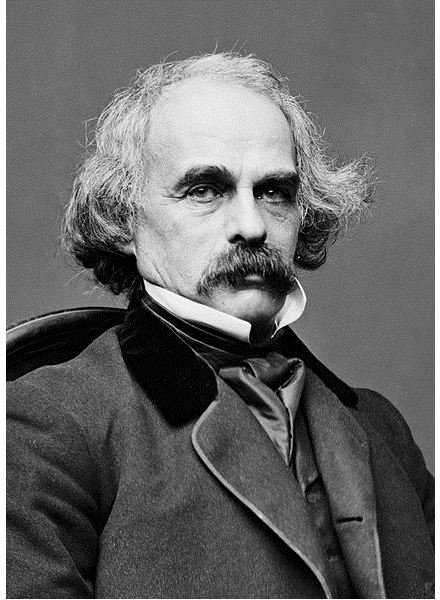"The Minister's Black Veil" Analysis & Summary
Summary
Before we get to our “Minister’s Black Veil” analysis, read the short story (it’s not much longer than my summary).
Reverend Hooper enters church with a mysterious black veil over his face, causing quite a stir among his parishioners. He delivers a sermon on secret sin and the things people hide in their hearts, “even forgetting the Omniscient can detect them.” After the meeting, the congregation discusses the minister’s veil, trying to interpret its meaning. The Reverend presents a funeral sermon and a wedding while wearing the veil, much to the dismay and disconcernment of the bride.
The entire town speaks of little else the next day. No one dare ask the minister to remove the veil or explain its presence except for his fiancee. He claims it is a sign of his sorrows and refuses to remove it. That was the last attempt to remove the veil. The veil causes children to flee and others to peep behind gravestones to get a look at his face. He becomes a highly respected minister in New England, notwithstanding the black barrier.
The Reverend Clark tries to persuade Hooper, on his death bed, to remove the veil. His reply: “Why do you tremble at me alone? Tremble also at each other! Have men avoided me, and women shown no pity, and children screamed and fled, only for my black veil? What, but the mystery which it obscurely typifies, has made this piece of crape so awful? When the friend shows his inmost heart to his friend; the lover to his best beloved; when man does not vainly shrink from the eye of his Creator, loathsomely treasuring up the secret of his sin; then deem me a monster, for the symbol beneath which I have lived, and die! I look around me, and, lo! on every visage a Black Veil!”
The minister is buried, wearing the veil.
Character Analysis
There’s really only one character in this story that matters and that’s the Reverend Hooper. He’s a tormented soul and feels the need to let everyone know by veiling his face, forever. The veil, as one might expect, has a chilling effect on his hearers and acquaintances. Why does he wear it? I think it’s because he’s a freak. We get the point Mr. Hooper. We are all composed of good and evil–a common element in Hawthorne’s characters–but do you have to wear that thing all the time? Here’s an idea, you freakish minister. Put it on one Sunday a month as a reminder to your congregation that they need to constantly purify themselves through the sacrifice of their God about whom he preaches. The reverend has little understanding of Christianity. It is the sacrifice of Christ that takes away one’s shame and suffering; his wearing of the veil undermines the infinite nature of that sacrifice.
Symbolism & Themes
Symbolism - it doesn’t take a rocket scientist or a Hawthorne scholar (Yes, there are literally hundreds of people who consider themselves Hawthorne scholars. They write treatises on mesmerism in Hawthorne’s work and other really long, boring articles that get published in scholarly newsletters that are bound and purchased by university libraries but nobody ever reads the bound and purchased articles unless they’re doing an equally boring research paper on Hawthorne that nobody will ever read; the fact that you’re reading this makes me more read than all the world’s Hawthorne scholars combined. Thank you.) to recognize the black veil as a symbol.
It doesn’t take some guy writing posts about symbolism in “The Minister’s Black Veil” with a Masters Degree in Literature to inform you that the black veil symbolizes secret sin. What may be new to you is the symbolic representation that all that is inward manifests itself outwardly. The funeral and the wedding also stand as symbols of death and life and the evil that resides in the human heart pervades even the most sacred events.
Irony - It’s ironic that the minister, more than likely one of the more holy men in town, feels the need to outwardly display his secret sins. It is also ironic that the minister, the messenger of God’s word, has little true understanding of Christianity (see above for details).
American Romanticism - “The Minister’s Black Veil” contains many of the elements of the American Romanticism literary movement, a movement that championed the individual and was fascinated with death and the supernatural. American Romantic writers often delved on the secrets of the human heart and soul.
Thesis Ideas
There’s a good chance your “Minister’s Black Veil” thesis ideas will revolve around…the black veil.
- The black veil represents… - this is where you finish the sentence. It might represent secret sin. It could represent the barrier that prevents humans from truly knowing each other. It could symbolize the lack of connection between ecclesiastical leaders and those whom they lead. It could represent man’s potential being overshadowed by wickedness. The ambiguity of the veil leaves it open for discussion.
- Reverend Hooper is a broken minister - this angle begs for a comparison with Hawthorne’s other famous minister, the Reverend Dimmesdale from the Scarlet Letter. Perhaps Hooper committed a sin and is trying to inform the public, but he doesn’t have the courage to come right out and say it. He attempts to relieve his guilty conscience by wearing the veil, knowing deep down inside, however, that the people will not assume that he has sinned.
- The veil makes Hooper a better minister - The veil isolates the reverend from human company, allowing him to understand the isolation one feels from god after having committed sin.
What’s your idea for a thesis?
References
- Nathaniel Hawthorne by Brady 1860-1865 - Public Domain
This post is part of the series: Study Guide for Nathaniel Hawthorne’s Short Stories
Nathaniel Hawthorne’s short stories are rich in meaning. Understand them better with these study guides.
